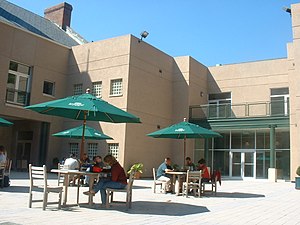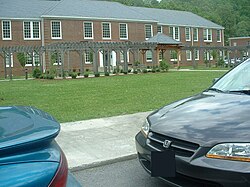This site is a developmental version of Wiki Law School. To go to the production site: www.wikilawschool.org
Appalachian School of Law
| Appalachian School of Law | |

| |
| Established | 1994 |
|---|---|
| Dean | Clinton W. Shinn (Interim) |
| Location | Grundy, VA, US |
| Enrollment | |
| Faculty | (See List) |
| Annual tuition | |
| Website | www.asl.edu |
| Outlines | 0 (See List) |
Appalachian School of Law is located in Grundy, VA
The Appalachian School of Law (ASL) is a fully-accredited private law school on a four building campus in Grundy, Virginia, a small town near the convergence of Virginia, Kentucky, and West Virginia. The school offers a three-year Juris Doctor degree, and enrolls approximately 370 full-time students.[1] The law school was founded in 1994 and it admitted its first class of students in August 1997. ASL was started and brought to Buchanan County, Virginia as a tool of economic development for the region. The school is fully accredited by the American Bar Association. ASL is notable for its focus to community service and leadership, emphasizing professional responsibility and alternative dispute resolution in its curriculum and requiring students to complete 25 hours of community service per semester in order to graduate. Each student is also required to complete an externship before graduation. ASL is also notable for the shootings that took place on campus January 16, 2002.
History
ASL traces its roots back to 1993 when Norton, Virginia lawyer Joe Wolfe came up with the idea to create a law school in Central Appalachia. His idea was well received by local business leaders and a steering committee was founded in 1994 and grew to eighty members. The committee surveyed lawyers and found that legal education needed to emphasize professional responsibility and alternative dispute resolution as these pillars of law school were becoming more important in today's law practice. The committee gained permission of the Virginia General Assembly to start a law school in 1995 and continued to secure endorsements from local civic associations and industrial development authorities. Buchanan County, Virginia approached the committee in 1996 and offered the grounds and buildings of the former Grundy Elementary and Intermediate Schools to which the steering committee accepted.[2]
A $1 million loan (which was later converted into a grant) financed the buildings' renovations.[3]
The State Council of Higher Education in Virginia granted the school the ability to enroll students studying for the Juris Doctor Degree in 1997. The charter class of 71 students first attended classes on August 12, 1997.[2]
Buchanan County brought ASL to Grundy in order to revitalize a town that had been in a steady economic decline since the town's Flood of 1977. ASL has brought a positive economic impact on its home town, including spurring construction of rental homes and the opening of additional businesses in the area. ASL has become a success story for the concept of higher education as an economic development tool.[3] The school has brought in $12 million per year to the local economy.[4]ASL's economic success spurred the conception and implementation of the University of Appalachia College of Pharmacy which was founded in 2003 and opened its doors in 2005.[5]
January 2002 campus shooting
- Main Article: Appalachian School of Law shooting
On January 16, 2002, ASL Dean Anthony Sutin, Professor Thomas Blackwell, and 1L student Angela Dales were shot and killed by disgruntled student Peter Odighizuwa, 43, of Nigeria. When Odighizuwa exited the building, he was subdued by two students armed with personal firearms. At trial, Odighizuwa was found mentally competent, pled guilty to the murders to avoid the death penalty, and was sentenced to multiple life terms in prison.[6]
Profile
According to the Law School Admissions Council's 2005 profile, ASL's student body demographic was as follows: 88.5% Caucasian, 2.5% African American, 2.5% Asian American, 0.3% Mexican American, 0.5% Puerto Rican, and 0.5% Hispanic with 5.2% not reporting. 67.6% of the student body is male, while 32.4% of the student body is female. The student to faculty ratio in 2005 was 19.3 to 1 and typical first year class size is 101. For the fall 2005 entering class, 1302 applied for admission, of which 527 were granted admission and 149 matriculated into the first year class. The 25-75 percentile range for LSAT scores and undergraduate GPA is 147-152 and 2.64-3.33. 70% of graduates are employed nine months after graduation and 70% passed the Tennessee bar exam in 2005. (A plurality of ASL graduates choose to take the Tennessee bar exam. Other graduates choose other states including Virginia.)[7]ASL was ranked "fourth tier" in the U.S. News and World Report law school listings, its first appearance since becoming fully accredited.[8]
Appalachian School of Law was granted full accreditation by the American Bar Association on June 12, 2006. The school had been provisionally accredited by the ABA since February 2001. Students who complete their course of legal study at this approved law school are eligible to take the bar examination in all 50 states and the District of Columbia. Prior to February 2001, graduates of the school were allowed to sit for the bar examination in Virginia and West Virginia.[9]
Campus
The campus of ASL currently consists of three buildings, the main academic building, the Student Organization House, and the law library. A fourth building, Booth Hall, is under construction.
The main academic building was created from the town's former high school (and junior high school) and gymnasium complex; these buildings were joined and extensively remodeled and expanded as part of a $1 million[10] award-winning architectural project.[11] The main building contains an appellate courtroom (which doubles as the auditorium for large events), a trial courtroom, five seminar rooms, student mailroom, the Lion's Lounge, and faculty and staff offices. Most rooms are wired for internet access.[12]
The two-story law library is adjacent to the main building. The building has 24,780 square feet and has facilities for seminar classes and group study rooms. The library contains over 196,000 volumes. Once the former Grundy Elementary School, this building has also been extensively remodeled and features individual and group study areas, a computer lab, and both wireless and wired internet access. [13]
The student organization house, located across Slate Creek from the main campus, houses offices for student organizations including the Student Bar Association, Moot Court, and the Law Journal. A privately owned coffee shop operates out of this building during the school year.[12]
A fourth campus building, Booth Hall, is now under construction. Booth Hall will be situated behind and to the rear of the main academic building and law library. The building will have 58,000 square feet of space on three floors. Thirty three parking spaces will be situated on the first floor. Additional classrooms, including one that seats 150 students, computer lab, student lounges, and a conference room will be included in the new building. The building is estimated to be completed in 2008 and will house the school's Business Office and President's Office. The building will also house facilities for Southwest Virginia Community College, which will share classroom space with ASL.[14]
Academic program
Students at Appalachian complete the traditional law school curriculum as required by the American Bar Association (ABA); however, the school distinguishes itself from almost all of the other 192 ABA accredited law schools in the country, as its students are required to volunteer 25 hours each semester on community service projects, ranging from dispute resolution training to humane society management. Only 11 other law schools have similar mandatory programs.[15]
ASL offers a Pre-Admission Summer Opportunity (PASO) programs for students who have the potential to become good lawyers and law students but whose LSAT's and GPA's do not necessarily reflect their skills and talents. The program lasts four weeks, three of which are independent home study, the final week is the on-campus lecture and final exam. The top scorers on the final exam may be offered admission to the fall's first year class.[16]
First year students arrive one week before the academic year starts to partake in a one credit course called Introduction to Law which covers the basic skills needed in order to succeed in law school. Students also register for classes and finalize their financial aid needs then.[17]
First year students cover legal foundation courses: Torts (4 credits), Contracts (6 credits), Property (6 credits), Civil Procedure (5 credits), Criminal Law (3 credits) and Legal Process (6 credits). Legal Process teaches students legal research and writing. First-year students also take an orientation course to the community service program in the first semester and an additional legal research course in the second semester. First-year students may not take any electives.[18] Additionally, all first-year students are required to complete a 200-hour unpaid externship over the summer before their second-year. This requirement is usually met by students working as judicial clerks, interns in prosecutor and defense offices, state and federal governmental agencies, and private practices. Placements have included state supreme courts, the Environmental Protection Agency, and the U.S. Department of Justice. The school provides assistance in locating and obtaining these positions.[19] Second year students cover additional legal foundation courses: Constitutional Law (6 credits), Evidence (4 credits), Professional Responsibility (3 credits), and Secured Transactions (3 credits). Students also cover Trusts and Estates (3 credits) and Business Associations (3 credits), and are allowed to take electives, such as Appellate Advocacy. Students also fulfill their alternative dispute resolution requirement in the second year.[18]
Students in their third year have the most options when it comes to electives. Third year students are required to take Family Law (3 credits), Criminal Procedure (3 credits), Payment Systems (3 credits), and Tax Law (3 credits). Additionally, students have their capstone experience in a writing intensive seminar. Each students takes two practicums focusing on the practical aspects of legal practice.[18]
Alternative dispute resolution
ASL is distinguished by its requirement that all second-year students complete a mandatory Alternative Dispute Resolution (ADR) class. The school has also held ADR training in local schools; this program drew national attention, particularly from former U.S. Attorney General Janet Reno, who has publicly congratulated the school on this effort. [20] Students are given an overview of different types of conflict resolutions, particularly mediation, negotiation, and arbitration. Ethical issues are explored in addition to legal and policy ramifications. Students learn the strengths and weaknesses of each method of dispute resolution and learn which methods are appropriate for certain situations.[21]
Students also have the option of taking additional courses in their second and third years to earn certification for mediation under the "Lawyer as a Problem Solver" Certificate Program. Students must complete basic law school procedure courses, two ADR focused courses, and an additional problem solving skills course.[22] ASL offers two courses to fulfill this requirement: certified civil mediation, and advanced negotiation. The school has two faculty which solely teach alternative dispute resolution related courses.[23]
Student life
ASL has an active student body involved in activities not only on campus but within the local community and the legal profession as well.
Officially recognized student organizations on campus:[24]
|
|
ASL's student body governs itself through the Student Bar Association. The SBA is divided into three branches, the Senate, Executive, and the Honor Court. The Senate consists of three elected senators for the first year, second year, and third year classes. The Executive Branch consists of the Student Body President, Vice President, Secretary, and Treasurer, plus any committees that the President appoints to assist in his or her endeavors. The Honor Court consists of five elected judges, one for the first year class and two per upper class.[25]
ASL also fields moot court teams that compete in national competitions. Students can audition for the team through either the Appellate Advocacy class in the second year or through an annual intra-school moot court challenge in the fall of the third year.[26]
Journals
- Appalachian Journal of Law
- Appalachian Natural Resources Law Journal (Online Journal - Spring 2007)
External links and further reading
- ASL Web Site
- "Law and Community Service: The Appalachian School of Law" by Lynda McDaniel (Appalachian Regional Commission)
- "The Appalachian School of Law: Tried by Still True" by Wendy B. Davis (Stetson Law Review)
- LSAC Guide to ASL
- ABA Statistics for ASL
References
- ↑ Appalachian School of Law - Student Body,
- ↑ 2.0 2.1 Catalog 2006-2007,
- ↑ 3.0 3.1 Buchanan’s 10-year-old $2.5 million debt forgiven,
- ↑ Colleges bring coal country a fresh mine of resources,
- ↑ Open House,
- ↑ Davis, W. Jeremy, "Against All Sense and Reason or Change and the Art of Getting Lucky",
- ↑ LSAC Guide to the Appalachian School of Law,
- ↑ ASL Ranking,
- ↑ ASL Receives ABA Full Accredidation,
- ↑ VCEDA forgives loans for projects,
- ↑ Appalachian School of Law,
- ↑ 12.0 12.1 Catalog 2006-2007 (page 5),
- ↑ Library General Information,
- ↑ New Building Planned,
- ↑ Community Service,
- ↑ Admissions Procedure,
- ↑ Introduction to Law,
- ↑ 18.0 18.1 18.2 Curriculum,
- ↑ Externship,
- ↑ McDaniel, Lynda, "Law and Community Service: The Appalachian School of Law",
- ↑ Course Descrptions,
- ↑ ASL Graduate Begins Prestigious Masters of Law Program,
- ↑ Unique Aspects of ASL's ADR Curriculum,
- ↑ Student Organizations,
- ↑ SBA/ABA,
- ↑ ASL 3RD ANNUAL INTRASCHOOL MOOT COURT COMPETITION,
Template:Colleges and universities in Virginia Template:BuchananCountyVA






